Post By
Marc Tubelleja



Reviewed By
Jo S., Faheem H., and Marc T.
Post By
Marc Tubelleja
Reviewed By



Jo S., Faheem H., and Marc T.
Can you remember the Top 10 Poorest Countries in the World by GDP Per Capita? So, how would you feel if you had to live in a poor country from birth? It is often not their fault but the fault of the rulers who ruled the country, lack of resources, overpopulation, weaknesses in the administration, and cultural attitude barriers in the country. This has particularly affected the Asian continent and today the World’s #1 Source of Research-Based Content, The Daily Top 10′ s topic is the Top 10 Poorest Countries in Asia by GDP Per Capita.
According to the Top 10 Things Most Asian People are Tired of Hearing Post, Asia is the World’s Biggest continent and it is also the most populated, with about 4.5 million residents. Despite consistent economic development, more than 230 million people live in severe poverty, which is defined as surviving on less than $2.15 a day. As a result, food has become a big issue what food they can buy is often deficient in essentials like vitamins, minerals, and proteins.

So, let us find the Top 10 Poorest Countries in Asia by GDP Per Capita based on accurate data.
What is the Poorest Country in Asia by GDP Per Capita?

According to the Asia Foundation, the Asia region is still dealing with the effects of the COVID-19 epidemic, which has hindered economic progress. As we previously stated in the Top 10 Asia’s Best Job Market News and Trends in 2023, small firms in the service and small-scale manufacturing sectors, which account for a large component of the area’s economy, have been impacted the worst. After the COVID-19 disaster, the countries that claimed to have a poor economy in the Asia region became even more impoverished.
In addition, based on economics, the yearly grain should be calculated as a percentage of domestic production. Thus, long-term military conflicts are the primary reason for the state’s claim to have Asia’s weakest economy. As a result, poverty and unemployment have risen rapidly, and the economy is imploding and public services continue to be insufficient.
So without further ado, let us find out what the Poorest Country in Asia is by GDP Per Capita. But before that, you can learn about the other countries on the list. In addition to this, check out the Top 10 Asia’s Best Business and Finance News and Trends in 2023.
10
Myanmar (GDP $1,400.20)

Myanmar is located in Southeast Asia, bordered by India and Bangladesh on the west, Thailand and Laos on the east, China on the north, and the Bay of Bengal and the Andaman Sea on the south. The bulk of people live in rural regions, where poverty is twice as high, and depend on low-tech farming and fishing. According to the World Food Programme (WFP), 13.2 million Burmese are unsure where their next meal will come from, and the food they do receive is insufficient to fulfill their nutritional requirements.
According to a report by the Borgen Project, over 33,000 people might die in 2022 because of avoidable factors such as lack of vaccines and starvation. Not only that, but Myanmar has the highest maternal mortality rate in Southeast Asia, with 250 deaths per 100,000 live births, roughly double the regional norm. Despite having few natural resources, the nation maintains a vibrant agriculture industry that employs about half of the population.
9
Timor-Leste (GDP $1,381.20)
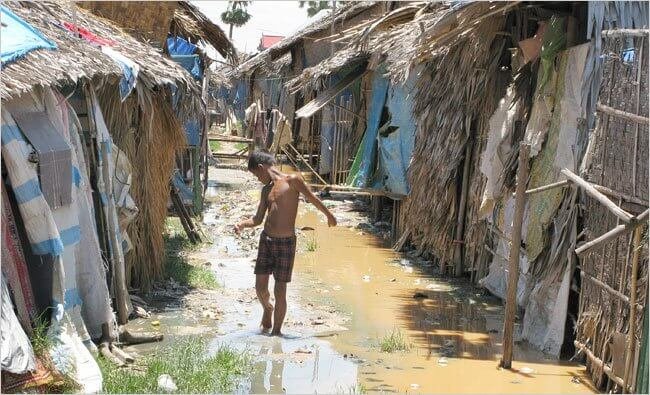
Timor-Leste is a small nation on the southern rim of the Indonesian archipelago. Locals generally rely on local agriculture to supplement their nutrition, and Timor-Leste’s frequent droughts, floods, and storms contribute to food insecurity. Timor-Leste’s persistent food instability and hunger have resulted in significant rates of malnutrition among Timorese kids and adults.
As mentioned in IMF, the World Food Program has supplied additional nourishment to the poorest Timorese while also working to lower maternal and newborn mortality rates since 1999. According to UNICEF, the death rate for children under the age of five is 50.5 per 1,000 live births. Food scarcity has also exacerbated a variety of ailments and illnesses, many of which are difficult to cure owing to a lack of medical resources.
8
Pakistan (GDP $1,193.70)

Pakistan is in South Asia and consists of four provinces: Punjab, Khyber Pakhtunkhwa, Sindh, and Balochistan. More than 40% of the population is presently believed to be living in severe poverty. The World Food Programme (WFP) predicted that 5.1 million people were on the verge of starvation by the end of March. This is due to a variety of factors, including their political structure, corruption, and lack of democracy.
Meanwhile, inflation has reached about 25%, driving up the cost of the basics and making life even more difficult for individuals living in rural Sindh and Balochistan. According to the Gazette Review, not only is there an education issue, but the government barely spends 2.6 percent of its entire GDP on education, implying that more than half of its population is ignorant. According to the World Bank, the Pakistani government must make various reforms to address the serious issue of hunger and food scarcity.
7
Kyrgyzstan (GDP $1,173.60)
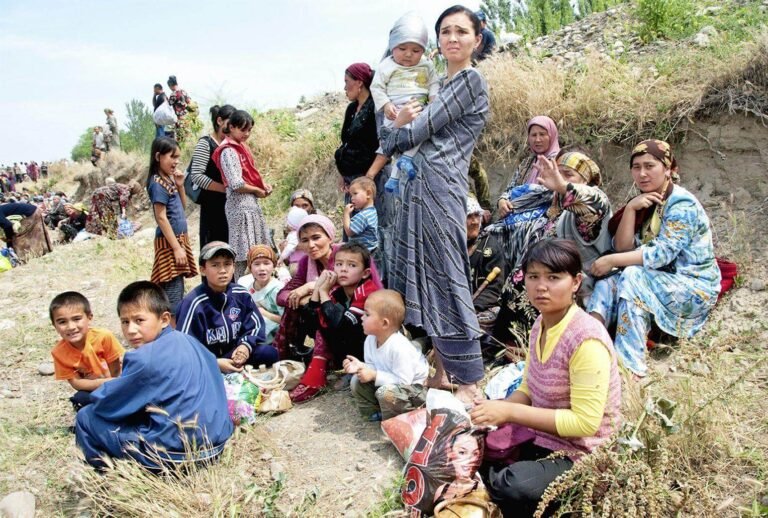
Kyrgyzstan is a landlocked Central Asian country with enormous mountain ranges that are complemented by thousands of rivers and streams. Poverty is also a major concern, with 32.1 percent of the population living in poverty. The country as a whole also has limited financial resources, making it difficult to sustain economic progress. Relatively few individuals have access to banks, making saving and investing impossible.
According to the World Food Programme, almost one-fifth of the population lives on less than US$1.3 per day. They spend more than 60% of their income on food, yet this is insufficient to supply them with the calories and minerals they require. The primary cause of nutritional difficulties, including vitamin and mineral deficits, is the high consumption of starchy meals rather than healthy ones. Stunting affects 1.8 percent of children under the age of five, and anemia affects 38.3 percent of the same age group.
6
Nepal (GDP $1,155.10)
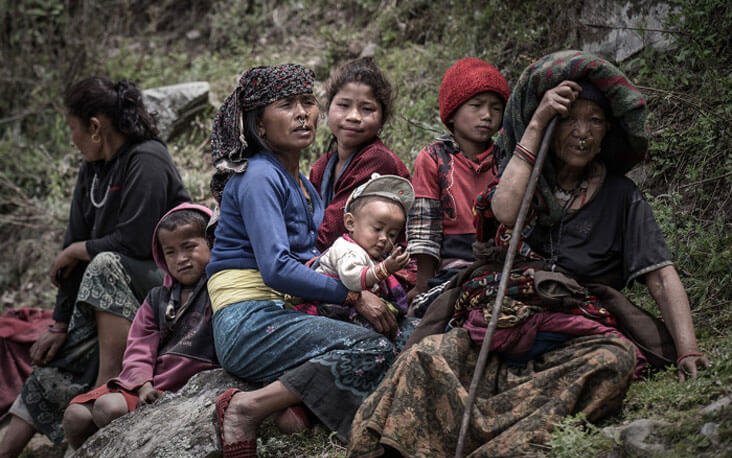
Did you know the Top 10 Most Amazing Facts About Nepal that You Never Knew? Accordingly, Nepal is a hilly nation in the Himalayas, located to the south of China and the north of India. Poverty and inequality remain important concerns in Nepal, despite recent improvements. Malnutrition, sickness, and child mortality are also prevalent, owing in part to a lack of medical facilities and high food prices.
To make matters worse, housing costs have risen in recent years, leaving many people unable to purchase a home. Agriculture is vital to the economy, but farmers face challenges due to miniature landholdings and low production. According to the World Bank, 25% of Nepal’s 28.5 million people lived on less than 50 cents a day, and 36% of children under the age of five were malnourished. Approximately, 36% of Nepali children under the age of five are chronically malnourished, which means their development is considerably hampered, or “stunted.”
5
Syria (GDP $870)
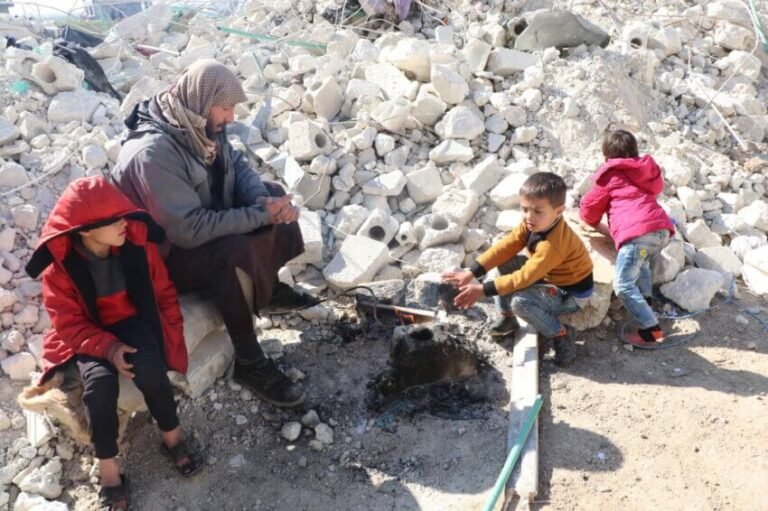
Syria is a Middle Eastern nation located on the Mediterranean Sea. The native currency has also continued to fall in value, resulting in severe inflation. Many people have lived in extreme poverty since the beginning, with little access to health, education, housing, water, and employment prospects. According to Trading Economics, approximately 90% of the population will be living below the poverty line by 2023, representing an 800% rise over the previous two years.
Not to mention the current conflict in Ukraine, which has had numerous economic ramifications. Food costs are 20 times higher than they were before the conflict, with a basic food basket that cost 4,000 Syrian pounds before the conflict now costing 76,000 Syrian pounds. Families have been compelled to take extreme steps, ranging from decreasing meals and portion sizes to selling possessions and plunging further into debt.
4
Tajikistan (GDP $859.13)

Tajikistan is a tiny Central Asian country bordered by China, Kyrgyzstan, Afghanistan, and Uzbekistan. Not only are unemployment rates high owing to a lack of stable work prospects, but the economy is also stagnant due to harmful infrastructure. More than half of the population gets its water from filthy sources, such as irrigation ditches, resulting in waterborne infections.
Tuberculosis is another serious health concern, with the country’s healthcare system ill-equipped to deal with it effectively. As reported by the Macro Trends, 9.1 million people suffer ongoing food-security concerns; malnutrition rates remain the highest in Central Asia, albeit declining over the last decade. For the 64% of Tajiks who live below the national poverty line, this means suffering additional costs while already earning less than $2 per day.
3
Yemen (GDP $824.1)
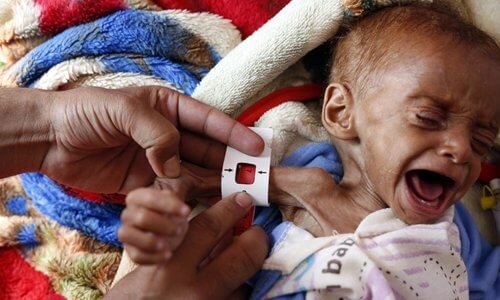
Yemen is a desert nation located in the Arabian Peninsula’s southern corner. According to Fred, approximately 55 percent of the population is poor, with 20 percent living in severe poverty. More than 11 million people have become destitute because of the war; many of them are children. Hunger and malnutrition, which frequently happen during the famine, as well as dengue fever, measles, and cholera, are important challenges.
Yemen’s maternal and child malnutrition rates remain among the worst in the world, with 1.3 million pregnant and nursing women and 2.2 million children under the age of five requiring treatment for acute malnutrition. The present level of hunger is unparalleled, imposing enormous suffering on millions of people. In addition, the country lacks schooling facilities and instructors, which means that approximately two million children are out of school, and their destitute situations would only worsen without a good education.
2
North Korea (GDP $642.00)
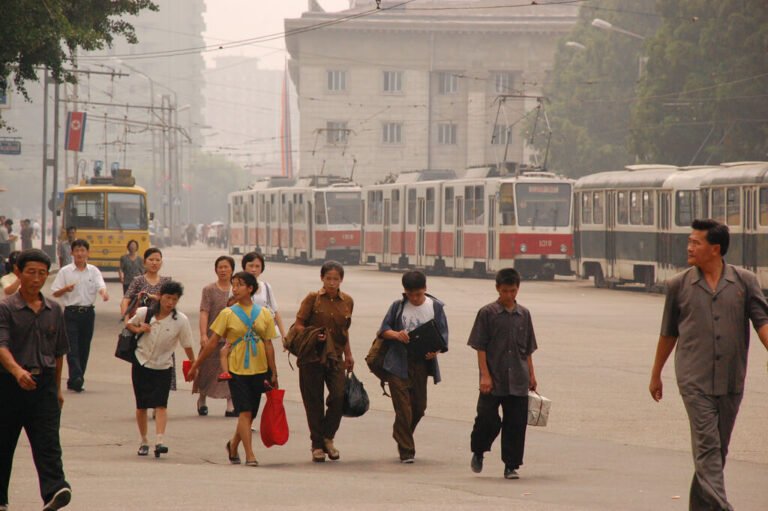
North Korea is located in eastern Asia, between the Sea of Japan and Korea Bay. It has a command economy, which implies that the government controls all monetary dealings. The country also has stringent trade restrictions, and poverty is pervasive owing to a lack of engagement in the global economy.
According to Aljazeera, 10 million people in North Korea are considered food insecure. 140,000 children under the age of five will be malnourished in 2023, and greater rates of hunger and death are expected while food scarcity is also a big concern, owing in part to the severe climate and harsh conditions. The grain crisis has resulted in malnutrition, hunger, and malnourishment, which increased with the epidemic. However, in addition to a lack of technology and farming equipment, North Korea has a far longer-term issue if it wishes to ensure its food supply.
1
Afghanistan (GDP $508.80)

Let us now look at a few facts concerning Afghanistan, which has Asia’s most deprived economy. Afghanistan is a landlocked nation with rugged mountains, deserts, and deep canyons. Nearly 40% of citizens in Asia’s poorest country live below the poverty line. Worse, a majority of Afghans do not have access to safe drinking water, electricity, or sanitation. Corruption, poor government, socioeconomic inequality, insecurity, and a lack of infrastructure have all increased the situation.
According to the Ifrc, 70% of households are unable to satisfy basic food and non-food needs, with particularly catastrophic consequences for widows, the elderly, persons with disabilities, and children. Due to decreased immunity, an estimated 3 million children are at risk of malnutrition and are vulnerable to infections such as acute watery diarrhea and measles. By 2023, a startling 95 percent of inhabitants would be food insecure. This is especially true for female-headed families, where the figure approaches 100%. Therefore, Afghanistan is the Poorest Country in Asia by GDP Per Capita.
What are the Poorest Countries in Asia by GDP Per Capita?

Especially in these countries, children of school age have lost their education and have to work at an early age. It is a very sad situation and in addition, poverty has several facets, including access to necessities such as food, clean water, medical care, schooling, housing, and social assistance.
Based on these criteria, we chose the ten poorest Asian nations, ranking them in descending order of GDP per adult. Among them, Afghanistan is the Poorest Country in Asia by GDP per Capita. In addition to this, don’t forget to check out the Top 10 Asia’s Biggest Political Scandals of All Time.
Here are the Top 10 Poorest Countries in Asia by GDP Per Capita:
- Afghanistan (GDP $ 508.80)
- North Korea (GDP $ 642.00)
- Yemen (GDP $ 824.1)
- Tajikistan (GDP $ 859.13)
- Syria (GDP $ 870.00)
- Nepal (GDP $ 1153.00)
- Kyrgyzstan (GDP $ 1173.60)
- Pakistan (GDP $ 1193.70)
- Timor-Leste (GDP $ 1381.20)
- Myanmar (GFP $ 1400.00)
We, The Daily Top 10 Team believe that no matter which continent you live on, this article will contain a lot of important information for your common sense. So, do you need to read more articles from our Asia Category? If so, read and enjoy the Top 10 Most Dangerous Active Volcanoes in Asia, Top 10 List of Most Spoken Languages in Asia, and the Top 10 Asia’s Best Business Leaders Who Made an Impact in 2023.
PIN IT!
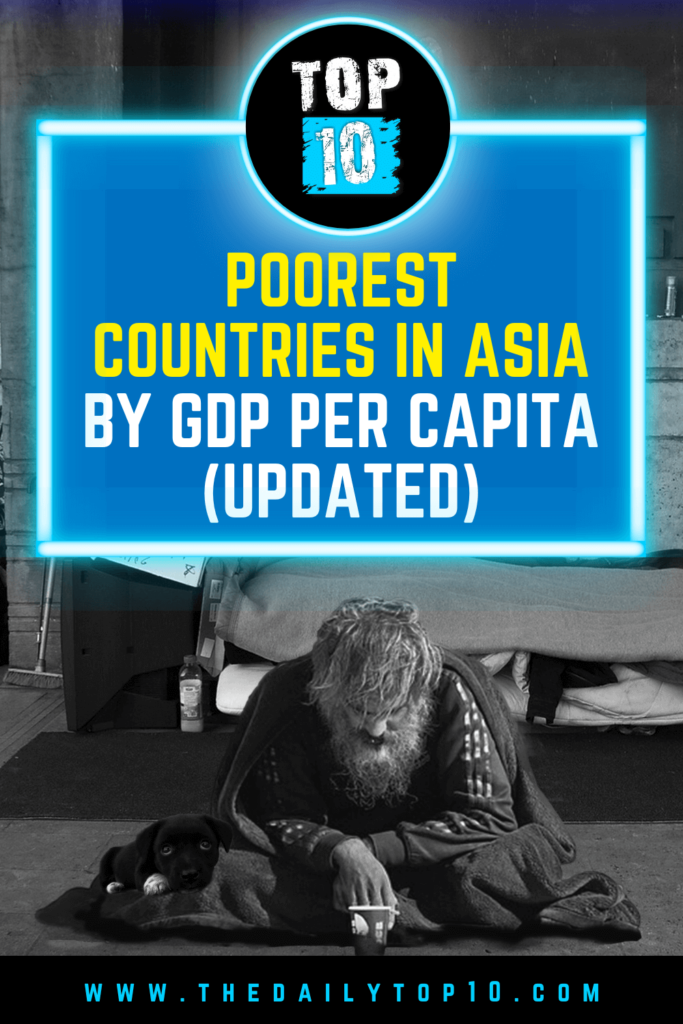





Top 10 Asia’s Best Pancake Recipes You Should Try
Top 10 Asia’s Best & Most Influential Women on LinkedIn (2022)
Top 10 Asia’s Biggest Political Scandals of All Time
Top 10 Best & Most Popular Ways to Make Money Faster (Updated)
Top 10 Asia’s Best Chocolate Cake Recipes You Should Try
Top 10 Best & Highest Paying In-demand Jobs in Asia (Updated)